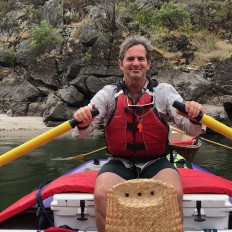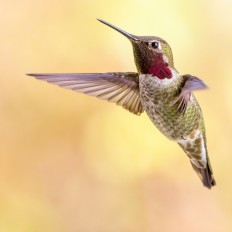This is a year-round birding spot though migration (March-May & August-October) and winter are more active and diverse. As these wetlands are the upper end of Tomales Bay, the rising and falling tides will result in water birds moving around. The east side of the wetlands are particularly good places to watch waterfowl (winter month especially for American and Eurasian Wigeon, Northern Pintail, Northern Shoveller, Green-winged Teal and Mallard) and shorebird (Greater Yellowlegs, Western & Least Sandpipers, Dunlin, Black-bellied & Semiplamated Plovers, Killdeer, dowitchers, and small numbers of Marbled Godwit, and Long-billed Curlew, rarer are Pectoral Sandpiper, Ruff, etc.) 1-2 hours before and after high tide. The upper (southern) end of the site includes open fields, small wet areas in winter and riparian (willow) habitat and can be productive year round (raptors, Savannah, Song, Swamp (rare), White- and Golden-crowned Sparrows, warblers, vireos, and many other songbirds. One of California's first records of Brown Shrike was found in the fields just north of White House Pool.
During the winter months Yellow Rails join Black and Virginia Rails in the wetlands though rarely seen except during tide events when the fall prey to Great Blue Herons and Great Egrets.
Either bicycle or car is the best way to get to the various trailheads or view points around the wetlands.
The Giacomini Wetlands are tidal wetlands at the upper end of Tomales Bay, and part of the Point Reyes National Seashore. These wetlands and adjoining upland and riparian habitats host a great diversity of species, and a visit is well combined with a visit to sites on the Point Reyes peninsula which provide some of the best birding in the United States.
This is a year-round birding spot though migration (March-May & August-October) and winter are more active and diverse. As these wetlands are the upper end of Tomales Bay, the rising and falling tides will result in water birds moving around. The east side of the wetlands are particularly good places to watch waterfowl (winter month especially for American and Eurasian Wigeon, Northern Pintail, Northern Shoveller, Green-winged Teal and Mallard) and shorebird (Greater Yellowlegs, Western & Least Sandpipers, Dunlin, Black-bellied & Semiplamated Plovers, Killdeer, dowitchers, and small numbers of Marbled Godwit, and Long-billed Curlew, rarer are Pectoral Sandpiper, Ruff, etc.) 1-2 hours before and after high tide. The upper (southern) end of the site includes open fields, small wet areas in winter and riparian (willow) habitat and can be productive year round (raptors, Savannah, Song, Swamp (rare), White- and Golden-crowned Sparrows, warblers, vireos, and many other songbirds. One of California's first records of Brown Shrike was found in the fields just north of White House Pool.
During the winter months Yellow Rails join Black and Virginia Rails in the wetlands though rarely seen except during tide events when the fall prey to Great Blue Herons and Great Egrets.
Either bicycle or car is the best way to get to the various trailheads or view points around the wetlands.
Year-round The Giacomini Wetlands are tidal wetlands at the upper end of Tomales Bay, and part of the Point Reyes National Seashore. These wetlands and adjoining upland and riparian habitats host a great diversity of species, and a visit is well combined with a visit to sites on the Point Reyes peninsula which provide some of the best birding in the United States.
This is a year-round birding spot though migration (March-May & August-October) and winter are more active and diverse. As these wetlands are the upper end of Tomales Bay, the rising and falling tides will result in water birds moving around. The east side of the wetlands are particularly good places to watch waterfowl (winter month especially for American and Eurasian Wigeon, Northern Pintail, Northern Shoveller, Green-winged Teal and Mallard) and shorebird (Greater Yellowlegs, Western & Least Sandpipers, Dunlin, Black-bellied & Semiplamated Plovers, Killdeer, dowitchers, and small numbers of Marbled Godwit, and Long-billed Curlew, rarer are Pectoral Sandpiper, Ruff, etc.) 1-2 hours before and after high tide. The upper (southern) end of the site includes open fields, small wet areas in winter and riparian (willow) habitat and can be productive year round (raptors, Savannah, Song, Swamp (rare), White- and Golden-crowned Sparrows, warblers, vireos, and many other songbirds. One of California's first records of Brown Shrike was found in the fields just north of White House Pool.
During the winter months Yellow Rails join Black and Virginia Rails in the wetlands though rarely seen except during tide events when the fall prey to Great Blue Herons and Great Egrets.
Either bicycle or car is the best way to get to the various trailheads or view points around the wetlands.
Year-round birding though migration (March-May & August-October) and winter are more active and diverse. As these wetlands are the upper end of Tomales Bay, the rising and falling tides will result in water birds moving around. The east side of the wetlands are particularly good places to watch waterfowl (winter month especially for American and Eurasian Wigeon, Northern Pintail, Northern Shoveller, Green-winged Teal and Mallard) and shorebird (Greater Yellowlegs, Western & Least Sandpipers, Dunlin, Black-bellied & Semiplamated Plovers, Killdeer, dowitchers, and small numbers of Marbled Godwit, and Long-billed Curlew, rarer are Pectoral Sandpiper, Ruff, etc.) 1-2 hours before and after high tide. The upper (southern) end of the site includes open fields, small wet areas in winter and riparian (willow) habitat and can be productive year round (raptors, Savannah, Song, Swamp (rare), White- and Golden-crowned Sparrows, warblers, vireos, and many other songbirds. One of California's first records of Brown Shrike was found in the fields just north of White House Pool.
During the winter months Yellow Rails join Black and Virginia Rails in the wetlands though rarely seen except during tide events when the fall prey to Great Blue Herons and Great Egrets.
Either bicycle or car is the best way to get to the various trailheads or view points around the wetlands.




